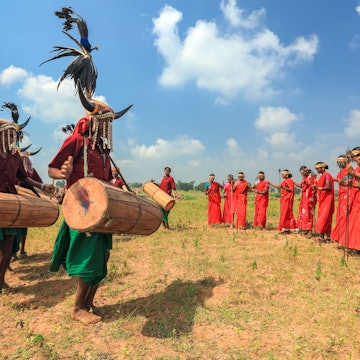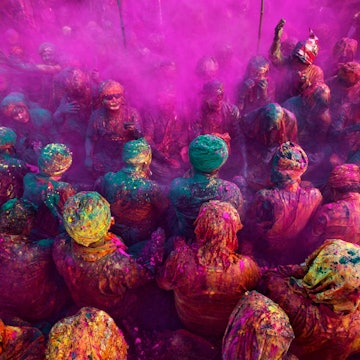

Sunrise over the dramatic boulder-covered landscape of the Jawai region in Rajasthan, India. Bkamprath/Getty Images
Set amid the rugged, granite-strewn wilds of Rajasthan’s Pali district, Jawai is a landscape like no other in India. Leopards roam freely among billion-year-old volcanic rocks, sheltering in natural caves and crevices scattered across the terrain. Add in fiery sunsets, bird-filled wetlands, and stylish wilderness lodges tucked among the hills, and you have one of India’s most captivating off-the-grid escapes.
A wildlife-watching visit here isn’t your usual safari – there are no gates, no fences and no promises. What Jawai offers instead are unscripted encounters with wilderness. Safari vans roll past millet fields shimmering in the breeze, while Rabari herdsmen, semi-nomadic pastoralists in white robes and crimson turbans, steer their flocks through the parched plains. Veiled women move with quiet elegance, balancing earthen pots carrying water on their heads. The landscape is ancient and alive, forged by volcanic fire and weathered by endless wind and sun.

Where is Jawai?
Though many imagine Jawai as a single place, it’s actually a vast region stretching across some 60 sq km, dotted with small villages, granite hills and open scrubland. The terrain is a dramatic mix of boulders, rivers and grasslands where wildlife thrives among rural life. While well-known Rajasthani villages like Bera, Perwa and Bisalpur attract most visitors, quieter hamlets such as Sena offer a more offbeat, intimate glimpse into this rugged landscape.
When is the best time to go to Jawai?
The best time to visit is October to March, when the weather is dry and cool, and temperatures range between 10°C to 25°C (50°F to 77°F), and wildlife sightings are more frequent. Mornings and evenings can be chilly, especially from November to January. Avoid peak summer (April to June), when it’s scorching.
How do you get to Jawai?
Jawai lies between Udaipur and Jodhpur in southern Rajasthan and is best reached via private transfer arranged through your lodge. The closest airports are Udaipur (145km/3.5 hours) and Jodhpur (170km/4 hours). If you're traveling by train, Jawai Bandh Station, on the Ahmedabad–Delhi line is the closest rail link. It takes approximately two hours and 30 minutes to drive to Jawai from Udaipur, Jodhpur or Mt Abu. Road conditions are generally good.

What are the best things to do in Jawai?
Go on an unmissable leopard safari
Jawai’s leopards are surprisingly visible, often seen basking on sun-warmed rocks above villages or gliding silently through the scrub. Unlike India’s national parks, safaris here are community-led, guided by local trackers, many of them Rabari herders or naturalists whose Indigenous knowledge of the terrain leads to respectful, thrilling sightings.
Safaris take place at dawn and dusk in open-top 4WD vehicles, unfolding at nature’s rhythm rather than a checklist pace. Leopards are often spotted near hillside temples or rocky ledges at sunset, and with luck, you’ll also see hyenas, nilgai, foxes and bears.
Many lodges fund livestock-compensation and conservation efforts, helping sustain the fragile coexistence between people and predators. Safaris are usually arranged through your lodge’s naturalists, though you can also link up with independent experts like Rajendra Singh Ranawat (+91 79 7606 7136). A private safari for up to six guests typically costs about ₹4000.
Meet people from the Rabari community
Draped in white dhotis and colorful turbans, the Rabari are semi-nomadic herders who have grazed their livestock across these hills for generations, living in quiet harmony with the leopards. Visiting their villages, arranged through some lodges, offers a rare glimpse into pastoral life: camel herding, traditional crafts and spiritual beliefs that regard leopards as sacred guardians rather than threats. These encounters are respectful and immersive, providing insight into a way of life that has endured for centuries. Ask your lodge about community partnerships to ensure ethical cultural tourism and that your visit financially supports local guides. Lodges, such as Bera Safari Lodge, work closely with local communities to make these experiences meaningful.

Bird-watch at Jawai Bandh
While leopards are the main draw, Jawai Bandh attracts more than 100 bird species, including flamingos, bar-headed geese and cranes. Constructed by Maharajah Umaid Singh in 1946, the dam remains a vital water source for the region. Early mornings are the best time for bird-watching, when the wetlands are alive with movement, and crocodiles can sometimes be spotted sunning themselves on the banks. Lodges such as Aaramgaah Jawai Resort & Spa and Bera Safari Lodge occasionally host sundowners here, combining wildlife viewing with a relaxed, scenic experience.
Hike to Kala Pahad (Black Hill)
Known locally as Kala Pahad, this granite outcrop rewards a short (30-minute) but steep hike with sweeping 360-degree views of Jawai Dam and the surrounding hills. Sunrise and sunset are particularly striking, bathing the landscape in golden light. Sturdy shoes, water and a steady pace are essential, though cars can also transport visitors to the top for those who need a gentler ascent.
Feast on local cuisine
Rajasthani food in Jawai is as rich and bold as the landscape itself. Signature dishes include dal baati churma, with golden, ghee-soaked wheat dumplings and sweet churma; tangy tomato sev sabzi, bursting with spice and texture; and panchkuta, a medley of five hardy desert vegetables. Crisp makai rotis, smoky and aromatic, accompany each dish, bringing the flavors of the arid land vividly to life. Every bite tells a story of survival, tradition, and centuries-old culinary heritage.
Take a historic or cultural side trip
Explore beyond Jawai with a two-hour journey to Kumbhalgarh, an isolated UNESCO-listed fortress that boasts massive ramparts, epic views and one of the longest walls in the world. For a cultural detour, head to Ranakpur Jain temples. These 15th-century marble temples nestled in forested hills feature exquisite carvings and statues.

What should I pack for a Jawai safari?
Neutral-colored clothing
Warm layers and a jacket for early morning safaris
Good hiking shoes
Binoculars and a camera with a good zoom lens
Sunscreen and a hat
Where are the best places to stay in Jawai?
Suján Jawai offers the most exclusive safari experience in the region with a pioneering approach to conservation.The property has luxury tents, with a spa and restaurant, impeccable service, and top-tier wildlife tracking. Room rates start at around ₹100,000 per night inclusive of safaris and meals.
Bera Safari Lodge is a boutique property, with luxurious cottages, that works closely with local conservationists and communities. It offers a range of activities from cooking classes to meeting local communities. Room rates start at around ₹27,500 per night inclusive of safaris and meals.
Aaramgah Jawai Resort & Spa is a stylish retreat blending adobe architecture with creature comforts. It's a great choice for families with activities including archery, rock climbing and pickle ball, and serves delicious local fare. Room rates start at ₹23,000 per night.
Jawai Leopard Safari Lodge is a more rustic, budget-friendly option with access to local guides and no-frills charm. Nightly rates start at ₹13,500.















